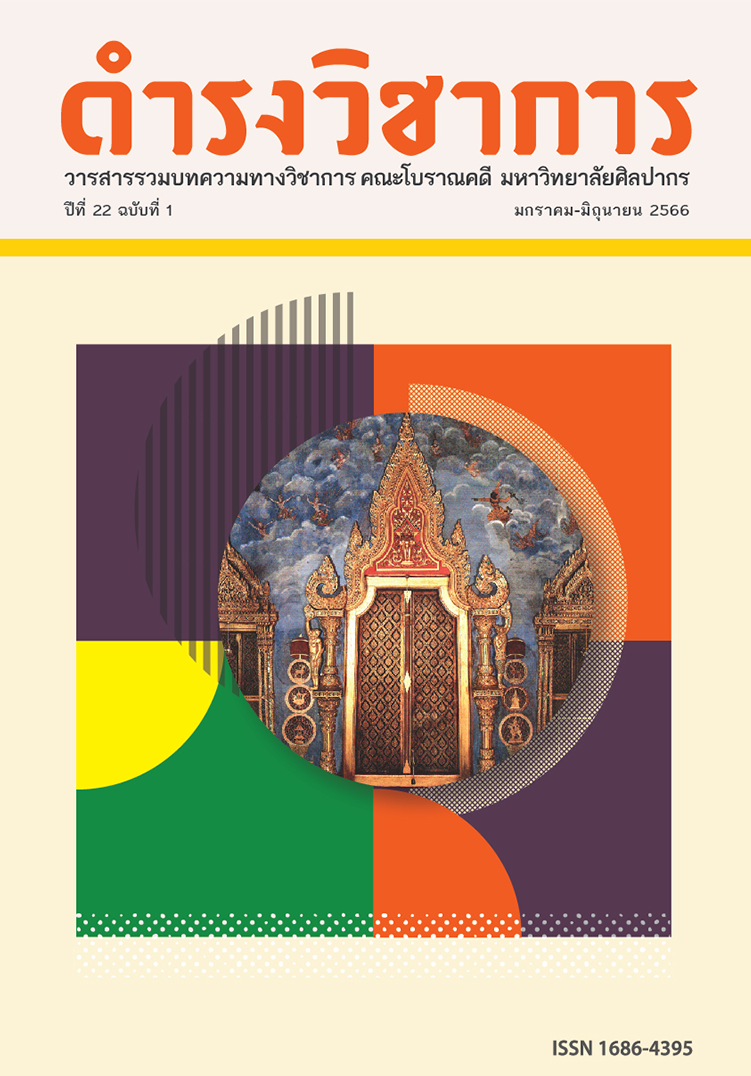การเปลี่ยนแปลงทางสถาปัตยกรรมของหอพระไตรปิฎกที่อยู่ในเขตสังฆาวาส ในรัชกาลพระบาทสมเด็จพระนั่งเกล้าเจ้าอยู่หัว
คำสำคัญ:
หอพระไตรปิฎก, เขตสังฆาวาส, พระบาทสมเด็จพระนั่งเกล้าเจ้าอยู่หัวบทคัดย่อ
หอพระไตรปิฎกเป็นงานสถาปัตยกรรมที่มีแบบแผนและมีลักษณะพิเศษกว่าอาคารใด ๆ ในเขตสังฆาวาส สะท้อนถึงการใช้งานและแนวคิดความหมายอันเป็นที่ประดิษฐานพระธรรมเจดีย์ แบบแผนประการสำคัญที่สืบทอดมาจากสมัยอยุธยาตอนปลายและยังคงปรากฏในสมัยต้นกรุงรัตนโกสินทร์คือการเป็นเรือนไม้ยกพื้นที่ตั้งอยู่บนเสาสูงกลางสระน้ำ ประกอบด้วยผังที่มีระเบียงโดยรอบ และมีการประดับตกแต่งที่พิเศษแสดงถึงเรือนฐานานุศักดิ์สูง บทความนี้มีวัตถุประสงค์เพื่อให้ทราบถึงการเปลี่ยนแปลงที่เกิดขึ้นกับรูปแบบศิลปะและสถาปัตยกรรมของหอพระไตรปิฎกในรัชกาลพระบาทสมเด็จพระนั่งเกล้าเจ้าอยู่หัวว่ามีการเปลี่ยนแปลงไปอย่างไรและมีองค์ประกอบใดที่เปลี่ยนแปลงไปบ้าง รวมทั้งมูลเหตุที่มาของการเปลี่ยนแปลงนั้น
การเปลี่ยนแปลงทางสถาปัตยกรรมของหอไตรครั้งสำคัญเกิดขึ้นในรัชกาลพระบาทสมเด็จพระนั่งเกล้าเจ้าอยู่หัว คือการเปลี่ยนวัสดุและโครงสร้างจากเรือนไม้ไปเป็นอาคารเครื่องก่อ ซึ่งเกิดขึ้นพร้อมกับการรื้อและปรับเปลี่ยนหมู่กุฏิทั้งหมดในเขตสังฆาวาส เมื่อคราวที่โปรดฯ ให้มีการบูรณปฏิสังขรณ์พระอารามต่าง ๆ ในครั้งนั้น แบบแผนสำคัญของหอไตรที่ยังคงอยู่คือการยกพื้นอยู่บนเสาหรือฐานสูง รวมทั้งผังพื้นที่มีระเบียงโดยรอบ และการประดับตกแต่งที่แสดงถึงฐานานุศักดิ์ สิ่งที่เปลี่ยนแปลงไปนอกจากวัสดุและโครงสร้างที่เป็นเครื่องก่อคือองค์ประกอบในผังและตำแหน่งที่ตั้งซึ่งไม่ได้ตั้งอยู่กลางสระน้ำอีกต่อไป และมักไม่ใช่อาคารโดดที่ตั้งโดยลำพัง แต่จะตั้งอยู่รวมเป็นส่วนหนึ่งของกลุ่มอาคารในเขตสังฆาวาส โดยมีการนำแนวคิดในเรื่องการวางผังบริเวณหรือการจัดกลุ่มอาคารแบบเรือนพักอาศัยเครื่องไม้มาใช้ เช่นการมีส่วนของชานหรือลานซึ่งเป็นพื้นที่เปิดโล่งเชื่อมต่อระหว่างเรือน มีรั้วกำแพงชักเชื่อมต่อกับอาคารอื่นสร้างพื้นที่ปิดล้อมภายในหมู่เรือน ซึ่งเป็นลักษณะสำคัญของการวางผังบริเวณที่พบได้โดยมากของหอไตรเครื่องก่อในกลุ่มนี้
เอกสารอ้างอิง
ไขแสง ศุขะวัฒนะ, 2526. วัดพุทธศาสนาที่ได้รับอิทธิพลศิลปะจีนในสมัยต้นกรุงรัตนโกสินทร์.กรุงเทพฯ: โรงพิมพ์จุฬาลงกรณ์มหาวิทยาลัย
โชติ กัลยาณมิตร, 2548. พจนานุกรม สถาปัตยกรรมและศิลปะเกี่ยวเนื่อง. กรุงเทพฯ: เมืองโบราณ
ดำรงราชานุภาพ, สมเด็จพระเจ้าบรมวงศ์เธอ กรมพระยา, 2513. ตำนานพระพุทธเจดีย์. ธนบุรี: ศิลปาบรรณาคาร
ทิพากรวงศ์, เจ้าพระยา, 2478. พระราชพงศาวดาร กรุงรัตนโกสินทร์ รัชกาลที่ 1. พระนคร: โรงพิมพ์พระจันทร์
_______, 2504. พระราชพงศาวดาร กรุงรัตนโกสินทร์ รัชกาลที่ 3 เล่ม 2. กรุงเทพฯ: โรงพิมพ์คุรุสภา
น. ณ ปากน้ำ, 2541. ศิลปกรรมในบางกอก. กรุงเทพฯ: บริษัทเลิฟแอนด์ลิพเพรส จำกัด
นิยะดา เหล่าสุนทร (บรรณาธิการ), 2544. ประชุมจารึกวัดพระเชตุพน. กรุงเทพฯ: อมรินทร์พริ้นติ้งแอนด์พับลิชชิ่ง จำกัด (มหาชน)
แน่งน้อย ศักดิ์ศรี, หม่อมราชวงศ์ และคณะ, 2531. สถาปัตยกรรมพระบรมมหาราชวัง. กรุงเทพฯ: โรงพิมพ์กรุงเทพ (1984) จำกัด
ปรมานุชิตชิโนรส, กรมสมเด็จพระ, 2544. ประชุมจารึกวัดพระเชตุพน. กรุงเทพฯ: อมรินทร์พริ้นติ้งแอนด์พับลิชชิ่ง จำกัด (มหาชน)
ประชา แสงสายัณห์, 2540. “กุฏิก่ออิฐถือปูน.” วิทยานิพนธ์ปริญญาสถาปัตยกรรมศาสตรมหาบัณฑิต สาขาวิชาสถาปัตยกรรมศาสตร์ ภาควิชาสถาปัตยกรรม บัณฑิตวิทยาลัย จุฬาลงกรณ์มหาวิทยาลัย
ราชบัณฑิตยสถาน, 2550. พจนานุกรมศัพท์ศิลปกรรม อักษร ก ฮ ฉบับราชบัณฑิตยสถาน. กรุงเทพฯ: ราชบัณฑิตยสถาน
วินัย พงศ์ศรีเพียร, 2551. “พรรณนาภูมิสถานพระนครศรีอยุธยา เอกสารจากหอหลวง” (ฉบับความสมบูรณ์. กรุงเทพฯ: อุษาคเนย์
ศักดิ์ชัย สายสิงห์, 2551. งานช่าง สมัยพระนั่งเกล้าฯ. กรุงเทพฯ: มติชน
สันติ เล็กสุขุม, 2539. “จระนำ, จรณำ จินตนาการปราสาทจำลองของช่างไทย.” ศิลปวัฒนธรรม 17 (9): 154.
สุภัทรดิศ ดิศกุล, หม่อมเจ้า, 2502. “ประวัติหอเขียนวังสวนผักกาด.” ใน หอเขียนวังสวนผักกาด. พระนคร: ศิวพร
ดาวน์โหลด
เผยแพร่แล้ว
ฉบับ
ประเภทบทความ
สัญญาอนุญาต
ลิขสิทธิ์ (c) 2023 ดำรงวิชาการ

อนุญาตภายใต้เงื่อนไข Creative Commons Attribution-NonCommercial-NoDerivatives 4.0 International License.
บทความนี้เป็นผลงานของข้าพเจ้าแต่เพียงผู้เดียว และ/หรือเป็นผลงานของข้าพเจ้าและผู้ร่วมงาน ตามชื่อที่ระบุในบทความจริง และเป็นผลงานที่มิได้ถูกนำเสนอหรือตีพิมพ์ที่ใดมาก่อน





